
Dauntless - $$4.95
The Northrop BT-1 provided the basis for the SBD Dauntless, which began manufacture in 1940. Ed Heinemann led a team of designers who considered a development with a 1,000 horsepower Wright Cyclone powerplant. A year earlier, both the U.S. Navy and Marine Corps had placed orders for the new dive bombers, designated the SBD-1 and SBD-2 (the latter had increased fuel capacity and different armament).
WWII SBD Douglas Dauntless Naval Carrier Fighter
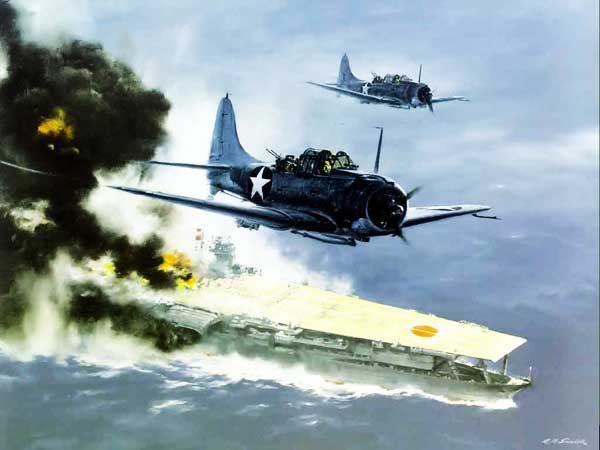
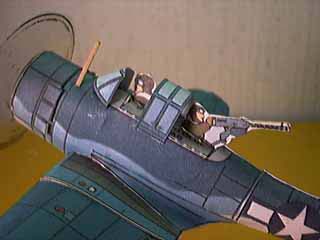 Developed in the mid 1930s as a carrier-based dive-bomber for the US Navy, the Dauntless was relatively slow and technically outmoded when it began its combat career in 1942.
Developed in the mid 1930s as a carrier-based dive-bomber for the US Navy, the Dauntless was relatively slow and technically outmoded when it began its combat career in 1942.
However, it was a rugged, dependable aircraft and by the time it gave way to the Helldiver it had gained the distinction of sinking more Japanese shipping than any other Allied aircraft.
This is one of my favourite models. It just looks great! and falls together beautifully.
Douglas SBD Dauntless
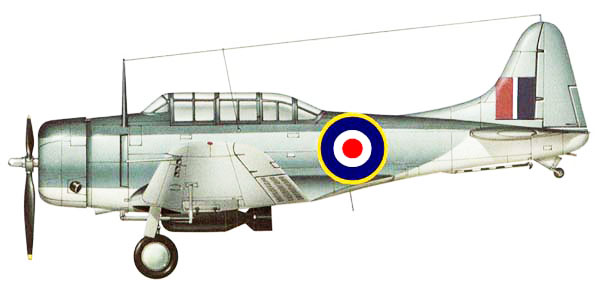
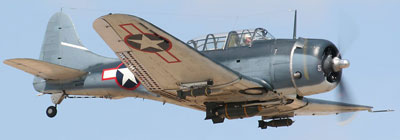 From December 1941, when Japan's attack on
Pearl Harbor brought the US fully and finally into World War II,
until the atomic bomb was unleashed against Japan to bring the
war to an end, the US Navy was primarily engaged in operations
against Japanese forces in the Pacific. For most of that time,
the principal carrier-based bomber available to Navy squadrons
was the Douglas SBD Dauntless, a refinement of the Northrop BT-l
that had been developed in 1935.
From December 1941, when Japan's attack on
Pearl Harbor brought the US fully and finally into World War II,
until the atomic bomb was unleashed against Japan to bring the
war to an end, the US Navy was primarily engaged in operations
against Japanese forces in the Pacific. For most of that time,
the principal carrier-based bomber available to Navy squadrons
was the Douglas SBD Dauntless, a refinement of the Northrop BT-l
that had been developed in 1935.Prototype ofthe SBD was a production Northrop BT-l, redesignated XBT-2 for development purposes. By the time this machine had undergone engine and structural changes that made it virtually a new airplane, the Northrop company had become the El Segundo Division of Douglas; it was therefore logical to give the new scout- and dive-bomber a Douglas, rather than Northrop, identity in its production form. Production orders were placed on April 8, 1939, for 57 SBD-ls and 87 SBD-2s. All the SBD-ls were sent to Marine Corps units, starting with VMB-2 late in 1940 and VMB-l in 1941; these units were renumbered VMSB-232 and VMSB132 at the end of 1941. The SBD-2s, with added armament and fuel capacity, equipped Navy squadrons VB-6 and VS-6 aboard the USS Enterprise and VB-2 aboard the Lexington by the end of 1941.
Whereas the SBD-1 and SBD-2 had two 030-in
guns in the cowling, plus one or two for rear defense, the SBD-3
which appeared in March 1941 had .050s in the cowling. Self-sealing
tanks were introduced, as well as protective armour, and the engine
was the 1,000 hp R-1820-52. Production, stepped up after Pearl
Harbor, totaled 584 and by December 1941 the SBD-3 was already
equipping VS-2 (Lexington), VS-6 (Enterprise), VB-5 and VS-S (Yo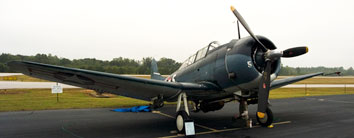 rktown)
and VB-3 and VS-3 (Saratoga). In the course of the following year,
many Marine squadrons, as well as additional Navy units, received
the SBD-3, and its successor on the El Segundo production line,
the SBD-4. The latter differed only in going over to a 24-volt
system; 780 were built for the Navy. Camera-equipped versions
of the Dauntless were designated SBD-IP, SBD-2P and SBD-3P.
rktown)
and VB-3 and VS-3 (Saratoga). In the course of the following year,
many Marine squadrons, as well as additional Navy units, received
the SBD-3, and its successor on the El Segundo production line,
the SBD-4. The latter differed only in going over to a 24-volt
system; 780 were built for the Navy. Camera-equipped versions
of the Dauntless were designated SBD-IP, SBD-2P and SBD-3P.
Almost identical to the SBD-4 was the 5BD-5 which was built at a new Douglas plant set up at Tulsa; this version had a 1,200 hp R-1820-60 engine and 2,409 were built for the Navy. Finally, Tulsa produced 451 SBD-6s with 1,350 hp R-1820-66 engines.In addition to these production totals were 168 SBD-3A, 170 SBD-4A, and 615 SBD-5A built for the USAAF, as the A-24, A-24A and A-24B respectively.
When the last SBD-6 was delivered, Douglas had built
5,321 examples, excluding the original Northrop machines.
THE BARGE, THE CLUNK: epithets bestowed on the Douglas Dauntless by its crews were legion and for the most part derogatory yet possessing an element of affection withal. Mundane by contemporary performance standards, the Dauntless was underpowered, painfully slow, short on range, woefully vulnerable to fighters, and uncomfortable and fatiguing to fly for any length of time, being inherently noisy and draught. But it did possess certain invaluable assets that mitigated these shortcomings. Its handling characteristics were, for the most part, innocuous and it was responsive; it was dependable and extremely sturdy, capable of absorbing considerable battle damage and remaining airborne, and, most important, it was an accurate dive bomber.
Throughout the Pacific War, it remained the principal shipboard dive bomber available to the US Navy; it was the only US aircraft to participate in all five naval engagements fought exclusively between carriers, and deficiencies notwithstanding, it emerged with an almost legendary reputation as the most successful shipboard dive bomber of all time-albeit success that perhaps owed more to the crews that flew it in truly dauntless fashion than to the intrinsic qualities of the aeroplane itself.
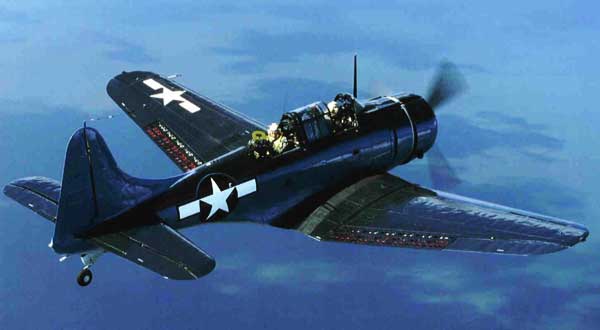
By the time I first flew the Dauntless, in early October 1944, its place in the annals of naval aviation was already thoroughly established, a fact undoubtedly coloring my attitude towards this trim but unimposing and relatively small aeroplane on first acquaintance. I found it hard to believe that this was the legendary scourge of the Japanese Navy; the principal US weapon employed in those climactic carrier battles of the Pacific. As I hoisted myself over the cockpit sill of JS997 Dauntless DB Mk I, the first of nine SBD-5 Dauntlesses supplied for evaluation by both the Royal Navy and the RAF, I recall wondering if this stocky but not displeasing aeroplane would reveal in flight some hidden quality not rendered evident by external appraisal.
The genesis of the Dauntless had been complex; its gestation had been protracted. My introduction to it came at a time when its service career had long passed its apex and its obsolescence, already tacitly admitted by the US Navy when first committing this warplane to combat, had degenerated to the obsolete. Its progenitors had been the Alpha, Beta and Gamma mailplane's of the late 'twenties and early 'thirties, and its true sire had been the Northrop XBT-1, which, embodying many of the structural techniques of the commercial models, had been created by Edward A Heinemann under John K Northrop. First flown on 19 August 1935, the XBT-l evinced sufficient promise to warrant a contract a year later, on 18 September 1936, for 54 production BT-ls, and these were to serve primarily with VS-S aboard USS Yorktown and VB-6 aboard USS Enterprise.
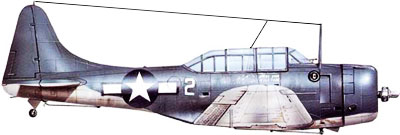 The BT-1 revealed few endearing characteristics; some aspects
of its handling were reputedly little short of vicious, particularly
at low airspeeds when lateral stability was exceptionally poor
and the rudder ineffective, a torque roll as likely as not accompanying
any application of power during a deck approach and several fatal
crashes ensuing. On the surface, the BT-1 provided a poor basis
for further development. Indeed, it is likely that evolution of
the basic design would have ended with delivery of the last of
the production aeroplanes but for an early amendment to the original
contract authorizing completion of one BT-1 as the XBT-2 with
an inward-folding fully-retractable undercarriage in place of
the aft-folding semi-retractable and faired arrangement. This
change, in itself hardly likely to translate sow's ear into silk
purse, was fortuitously, to set in train an incremental modification
program destined to recast the XBT-2 as the true forerunner
of the Dauntless.
The BT-1 revealed few endearing characteristics; some aspects
of its handling were reputedly little short of vicious, particularly
at low airspeeds when lateral stability was exceptionally poor
and the rudder ineffective, a torque roll as likely as not accompanying
any application of power during a deck approach and several fatal
crashes ensuing. On the surface, the BT-1 provided a poor basis
for further development. Indeed, it is likely that evolution of
the basic design would have ended with delivery of the last of
the production aeroplanes but for an early amendment to the original
contract authorizing completion of one BT-1 as the XBT-2 with
an inward-folding fully-retractable undercarriage in place of
the aft-folding semi-retractable and faired arrangement. This
change, in itself hardly likely to translate sow's ear into silk
purse, was fortuitously, to set in train an incremental modification
program destined to recast the XBT-2 as the true forerunner
of the Dauntless.
Right testing of the XBT-2 was initiated on 22 April 1938, revealing no significant advance over the BT-1, and had barely got under way when this prototype suffered quite extensive damage as a result of a wheels-up landing. Ed Heinemann seized the opportunity presented by the return of the aircraft to the factory for repair to eradicate one of the more serious shortcomings of the XST-2, its inadequate power, seeking and obtaining authority, on 21 June 1938, to replace the Twin Wasp Junior engine and two-blade controllable-pitch propeller with a more powerful. Cyclone and a three-blade constant-speed propeller. This change produced a noteworthy improvement in speed performance but exacerbated some of the least desirable handling characteristics of the aircraft.
Fixed slots were introduced on the wing to maintain aileron control at low speeds; a dozen different sets of ailerons were tested and no fewer than 21 different tail surface combinations were evaluated. The end product was an aeroplane possessing eminently more satisfactory handling characteristics; a high standard of maneuverability throughout the speed range, light control responses and a docile attitude towards carrier operation. In short, the prototype of the Dauntless.
The Northrop Corporation, which had been formed in January 1932 with the Douglas Aircraft Company holding 51 per cent of the stock, had meanwhile been dissolved and had become Douglas's El Segundo Division, and when a production contract for the reworked dive bomber was placed on 8 April 1939, this change and the adoption of the all embracing classification of scout-bomber were reflected by the assignment of the designation SBD, indicating Scout Bomber Douglas.
The first production Dauntless, an SSD-1, was flown on 1 May
1940 and delivered to the US Navy on 6 September. This was almost
identical to the definitive XBT-2, apart from the introduction
of two 15 US gal center section auxiliary tanks boosting
total capacity to 210 US gal and the installation of a
production series Wright Cyclone engine, the R-1820-32 affording
1,000 hp at 2,350 rpm for take-off and having a normal maximum
rating of 950 hp at 2,300 rpm from sea level to 5,000 ft.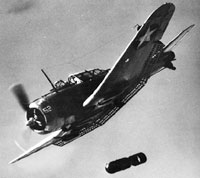
The SBD-1 undeniably offered a capability advance over the equipment that it succeeded, but such had been the tempo of combat aircraft development during its gestation that it no longer met US Navy requirements; the service was by now relying on the Curtiss SB2C for the quantum advance that it sought. Not that the Douglas , Northrop fell short of its guaranteed performance, but the Curtiss, ordered a year earlier, on 15 May 1939, bid fair to provide 58 mph more speed and tote twice the bomb load over substantially greater ranges. Thus, before its introduction to the carriers, the Dauntless was seen as being underpowered, with performance and load-carrying capabilities well below those foreseen to be demanded by the Pacific conflict now considered inevitable in most US Navy circles. It was already obsolescent'.
The structure of the Dauntless was extremely strong but also rather heavy, and with the chosen engine its power-to weight ratio inevitably resulted in a rather sluggish performance, especially with a worthwhile external load. The wing, which employed the "multi-cellular" system of construction originated by John Northrop, was a duralumin structure consisting of several false spars and plate ribs with 'top hat" section stringers supporting the flush-riveted dural sheet stressed skinning. The centre section was rectangular with the outer sections tapered in chord and thickness, but an odd feature of the wing for a shipboard aeroplane of the era of the SBD-1, was the lack of any provision for folding, the outer panels being rigidly affixed to the centre section by attaching angles and double plates, with characteristic fairing bulges covering the joints.
Fixed "letter-box" slots were inserted in the wings ahead of the metal-framed fabric-skinned ailerons, and the remainder of the wing trailing edges were occupied by combined spoilers and flaps, both upper and lower halves of these split surfaces being hinged. These were hydraulically operated, and the lower halves, which continued across the centre section, served in orthodox fashion for take-off and landing, the upper and lower halves being opened in unison to brake terminal velocity in a dive. These spoiler-flaps were extensively perforated with 175-in holes - an NACA Innovation - to inhibit tail buffeting.
The oval-section duralumin semi-monocoque fuselage was built up of channel-section transverse frames with extruded stringers and dural skinning. For ease of manufacture, the fuselage was split longitudinally, the upper half in one piece and the lower in three, plus a tail cone, the forward lower section including the built-in centre section. Aft of the rear cockpit, sheet metal bulkheads divided the rear fuselage into a series of watertight compartments. The tail fin was built integral with the fuselage and, like the tailplane, was of metal stressed-skin construction, the rudder and elevators being metal framed and fabric skinned.
The main oleo shock-absorber legs were cantilever units with stay struts mounted on knuckle forgings which rotated on retraction, the legs hinging at the extremities of the centre section and being raised hydraulically inwards, the wheels lying flat in wells forward of the main spar. The Cyclone engine was carried by a tubular steel mount and enclosed by an NACA cowling with controllable exit louvres on top of the cowling. A Hamilton Standard Hydromatic fully-feathering propeller was fitted, and all fuel was accommodated by unprotected centre section tanks and the previously mentioned auxiliary tanks.
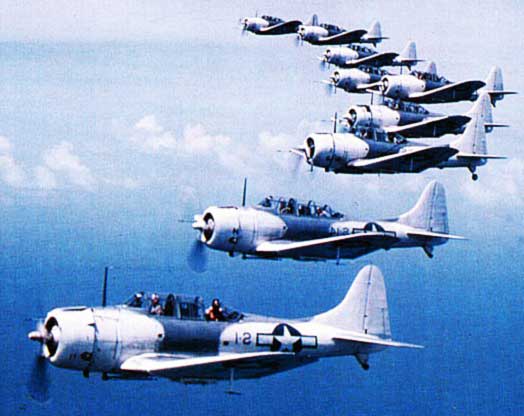 The pilot sat fairly high in the fuselage beneath a sliding
section of a continuous "greenhouse" canopy and was
provided with a pair of .05-in (12,7-mm)
Browning machine guns, the breeches of which protruded into the
cockpit where they could be cleared and cocked in the event of
a stoppage. Each gun was provided with 360 rounds stowed in containers
behind the fireproof bulkhead carrying the engine mount.
The pilot sat fairly high in the fuselage beneath a sliding
section of a continuous "greenhouse" canopy and was
provided with a pair of .05-in (12,7-mm)
Browning machine guns, the breeches of which protruded into the
cockpit where they could be cleared and cocked in the event of
a stoppage. Each gun was provided with 360 rounds stowed in containers
behind the fireproof bulkhead carrying the engine mount.
The observer-gunner had a single drum-fed .03-in (7,62mm) weapon with 600 rounds and which, when stowed, was accommodated by a compartment in the top of the fuselage which was closed flush by folding doors. The pilot was provided with a three-power telescopic sight which was intended for use both in aerial gunnery and dive bombing, and a duplicate set of controls was included in the rear cockpit for emergency use. A cradle beneath the fuselage could carry a single 500-lb, 1,000-lb or 1,600-lb bomb and swung forward and downward to ensure that its load cleared the propeller disc. A fixed rack for one 100-lb bomb was located under each Outer wing section.
The US Navy did not deem it advisable to deploy SBD-ls aboard its carriers, primarily because of their inadequate range, work already being in hand at El Segundo that was to increase internal fuel capacity by almost 50 per cent and a series of contractual changes allowing for the revised fuel system to be introduced with the 58th production aeroplane
Whereas the SBD-1 carried all fuel in welded centre section tanks comprising two 90 US gal main tanks and two 15 eliminated the auxiliary tanks and supplemented the two centre section main tanks with two 65 US gal tanks in the outer wing panels to raise maximum internal capacity to 310 US gal. However, it was only practical to use all the additional capacity for ferrying, the maximum ferry range being raised from 1219 miles at 142 mph to 1,689 at 147 mph. For operational missions, internal fuel was effectively limited to 260 US gal with which range with, for example, a single 500-lb bomb was increased by 388 miles to 1349 miles.
This quite considerable boost in range capability was not, of course, achieved without exacting penalties on take-off distance, climb rate, service ceiling and stalling speed, and, furthermore, reasons dictated removal of one of the 05-in (12,7-mm) cowl guns. The SBD-2 did introduce an automatic pilot, however. If unusual in so small an aeroplane, this piece of equipment was very desirable in view of the reconnaissance ranges of which the Dauntless was now capable.
Like the SBD-1,the SBD-2 as initially delivered to the US Navy was hardly to be considered combat worthy in that it lacked a bullet-proof windscreen, any form of armour protection or self-sealing fuel tanks - in the event, some SBD-2s were later to be fitted with aluminum alloy fuel tanks with self-sealing liners reducing total internal capacity to 260 US gal. By the time that the Japanese struck at Pearl Harbor, three US Navy squadrons, VS-6 and VB-6 aboard Enterprise and VB-2 aboard Lexington, were mounted on SBD-2 Dauntlesses, combat worthy or no, and deliveries of what can be considered the first fully combat worthy Dauntless, the SBD-3 had, in fact, begun nine months before hostilities started in the Pacific.
It was the SBD-3 that was to become the US Navy's true workhorse of the Pacific War and to carry much of the burden of that service's offensive operations until 1943, when the marginally more efficacious SBD-5 was to become available. Indeed, but for the availability of the SBD-3, the conflict in the Pacific might well have pursued a very different course during its first critical year. The SBD-3 was dubbed somewhat sardonically the Speedy Three", a caustically humorous allusion to the fact that it was anything but speedy, having taken on weight without any commensurate increase in power and all aspects of its performance suffering in consequence, although, in truth, only nominally so.
To me, the SBD-5 Dauntless looked exactly what it was: a decidedly pre-war aeroplane of obsolescent design and certainly overdue for replacement. Its primary purpose at the RAE Farnborough was for comparison with the Curtiss SBW-LB Helldiver and the Vultee Vengeance IV as a dive bomber, and of the nine supplied to the UK, four had been assigned to the Royal Navy and the remainder to the RAF for trials purposes. The combination of Wright Cyclone engine and Hamilton Standard Hydromatic propeller that I had come to appreciate so much in the Grumman Wildcat influenced me favorably but during my first take-off in this ageing dive bomber, my impression was that it needed every single one of the twelve hundred horses that its R-1820-60 Cyclone could muster, and with the lower-powered Cyclones of earlier models, carrier take-offs with any substantial external loads could well have bordered on the hairy!
The cockpit was commodious and offered relatively good view for take-off, which, in clean condition in calm from grass required some 1,200 ft. Once airborne, the Dauntless labored upwards at a maximum initial rate of 1,430 ft/mm, which, with a 1,000-lb bomb, was reduced to 1,190 ft/mm. During the climb, the cockpit was extremely noisy and drafty, and there were signs of lateral instability. It took about eight minutes to reach 10,000 ft and about another five to attain its Vinax critical altitude of 14,000 ft at which the clean aeroplane could just about touch 254 mph. I could not help but feel that, with so sluggish a performance, the Dauntless must have been an easy "kill" for the pilot of any determined Zero-Sen fighter, yet I was later to learn that its loss rate in the Pacific had been lower than that experienced with any other US Navy shipboard aeroplane - a tribute to its innate robustness and ability to survive quite heavy battle damage.
The practical combat radius of the SBD-5, based on 23 mile warm-up
and idling, to mm rendezvous at 60 per cent normal sea level power
and auto-lean, climbing to 15,000 ftand allowing for
five mm combat w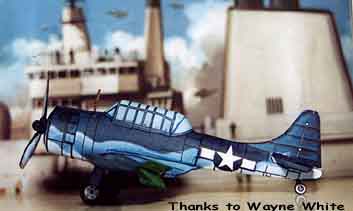 ith full military power at 1,500 ft,
plus 10 mm at max normal power, return at 1,500 ft and
60 mm for a rendezvous, reserve and landing, was 327 miles
with a single 500-lb bomb, this being increased to 450 miles with a pair of drop tanks, and these radii were certainly
not too great for Pacific-type operations. But although cockpit
noise must have been taxing on protracted flights at the 138 mph cruise of the Dauntless, the controls were light and
the pilot had the advantage of an auto-pilot - indeed, this was
the first auto-pilot that I had ever flown.
ith full military power at 1,500 ft,
plus 10 mm at max normal power, return at 1,500 ft and
60 mm for a rendezvous, reserve and landing, was 327 miles
with a single 500-lb bomb, this being increased to 450 miles with a pair of drop tanks, and these radii were certainly
not too great for Pacific-type operations. But although cockpit
noise must have been taxing on protracted flights at the 138 mph cruise of the Dauntless, the controls were light and
the pilot had the advantage of an auto-pilot - indeed, this was
the first auto-pilot that I had ever flown.
If the performance of the Dauntless was "sedate", particularly with external load, at least it had few vices. It was a pleasant aircraft to fly and its controls were light and responsive unless it was heavily laden, and its stall, which, power off, ranged from about 78 mph at 10,000 lb to some 71 mph at about 8,500 lb, was totally innocuous. But it did have one bad habit and that was a vicious stall, particularly off a tight left-hand turn, reminiscent of that of the Fw 190. It would snap inverted without warning, the nose falling through the horizontal and a spin ensuing if corrective action was not taken immediately.
My primary interest in the Dauntless lay in its dive bombing characteristics and so I staggered up to 15,000 ft, retarded the throttle, pulled up the nose slightly above the horizon on reaching the target and pulled the diamond shaped handle marked "D" on my right which deployed both spoilers and flaps in unison. These were very slow to operate and it was therefore necessary to activate them before half rolling into the dive and not on actually initiating the dive. Ideally, one flew slightly to one side of the target and once abreast began the dive, rotating onto the target with aileron. Acceleration was slow so that an angle between 70 and 75 deg was not as frightening as it could be in some of the Dauntless's contemporaries, and I only picked up a speed of 276 mph in the 35-40 seconds that it took me to get down to the bomb release height of 1,500 ft.
Using the Mk VIII reflector sight, which, in the SBD-5, had supplanted the telescopic sight of earlier models and which had had a tendency to fog over in a dive owing to the sudden temperature changes, and making line corrections easily with the pleasantly light ailerons, I could sense that the Dauntless was a very accurate dive bomber. I say "sense" advisedly, as I had neglected to activate the windscreen heater, which, too, had been introduced with the -5 sub-type, and the windscreen fogged over at around the halfway point of the dive. Needless to say, I did not neglect to use the heater in subsequent dives.
The bomb release was a red button marked "B" on the top of the stick, electrical arming and release circuits having replaced manual release partway through SBD-3 production, and there was a selector for individual bombs or salvo. The spoiler-flaps had to be retracted before commencing the pullout owing to their slow operation and their high drag which would have slowed the aircraft too much for tactical getaway if retraction had been left until after the pullout. In truth, the Dauntless could not easily maintain level flight with the upper spoilers extended. Recovery was positive, pulling about 5g, and while frankly, I did not consider the Dauntless to be as good a dive bomber as the Ju 87,1 was left with the opinion that it was certainly one of the most effective aeroplanes designed to fulfil that role.
Among the best features of the Dauntless were its landing characteristics which were very easy. View for deck landing was good, and the controls crisp and effective, the flaps giving adequate drag to require a reasonable increment of engine power, which, when cut, gave a very definite deceleration, although the undercarriage was a little on the bouncy side.
The SHD-5 was not quite the end of Dauntless evolution as, somewhat belatedly, a still more powerful version of the Cyclone was applied, the R-1820-66 offering 1,350 hp at 2,700 rpm for take-off and military ratings of 1,300 hp at 2,600 rpm from sea level to 4,000 ft and 1,000 hp from 11,300 to 17,500 ft . This power plant was installed in the final Dauntless production model, the SBD-6, but the heyday of the veteran dive bomber had long since passed and, as a result of contractual cutbacks, only 450 production SBD-6s were completed, these, with non-metallic self-sealing tanks of 284 US gal total capacity and ASV radar, were delivered between March and July 1944 to bring Dauntless production to an end.
The Dauntless remained until late 1944 the primary US Navy shipboard dive bomber and equipped no fewer than 20 US Marine Corps squadrons, but it faded from service rapidly with the end of hostilities. It had established an enviable record for reliability and toughness and its career in the Pacific had certainly been illustrious. Yet, from the performance standpoint it had been a very mediocre aeroplane and having operated for much of the time in a non air superiority environment, one is left with a deep respect for its crews. I personally did not find the hidden quality in the Dauntless that I had sought on the strength of its remarkable operational reputation. I could only conclude that it was to be numbered among that handful of aeroplanes that have achieved outstanding success against all odds.
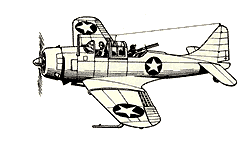
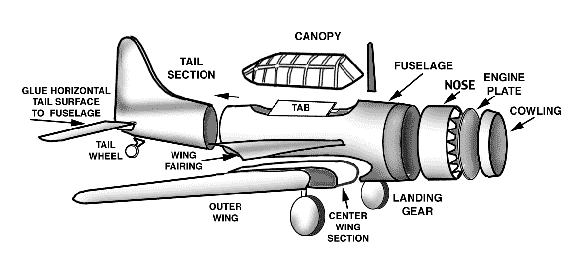
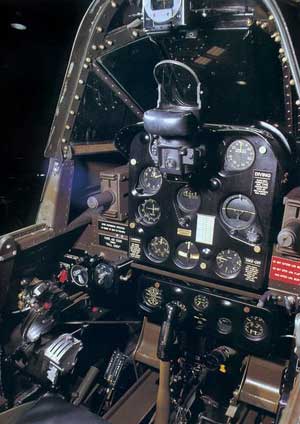 |
Douglas SBD-5 Dauntless Cockpit. |
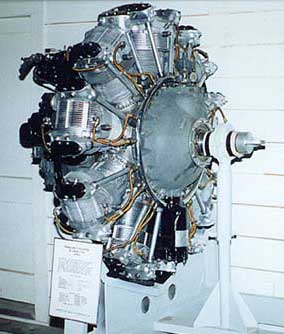 |
The Douglas SBD Dautless Wright Cyclone 1820 9-Cylinder Radial Engine. |
Specifications for the Douhlas SBD Dauntless
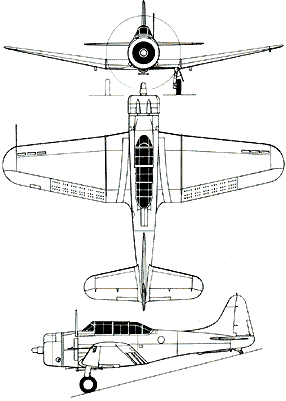 |
Crew: Two Length: 33 ft 1 in Wingspan: 41 ft 6 in Height: 13 ft 7 in Wing area: 325 ft² Empty weight: 6,404 lb Loaded weight: 10,676 lb Max takeoff weight: 10,700 lb Powerplant: 1× Wright R-1820-60 radial engine, 1,200 hp Performance Maximum speed: 255 mph Range: 773 mi Service ceiling: 25,530 ft Rate of climb: 1,700 ft/min Wing loading: 32.8 lb/ft² Power/mass: 0.11 hp/lb Armament Guns: 2 × 0.50 in (12.7 mm) forward-firing Browning M2 machine guns in engine cowling 1 × 0.30 in (7.62 mm) flexible- mounted Browning machine gun in rear (later versions fitted with 2 × machine guns of the same caliber). Bombs: 2,250 lb of bombs |
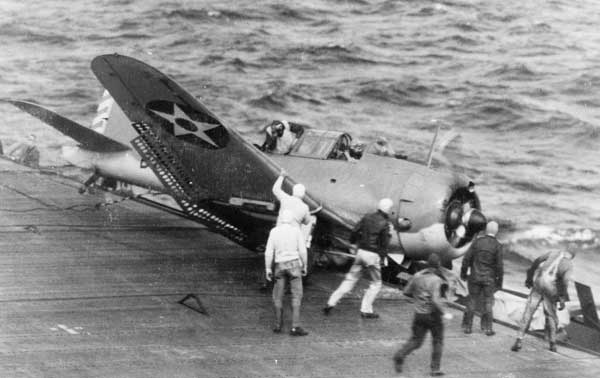 |
A U.S. Navy Douglas SBD-2/3 Dauntless of bombing squadron VB-6 crashes into the catwalk after catching an arrestor wire on the aircraft carrier USS Enterprise (CV-6) during operations in the Pacific, in early 1942. |


